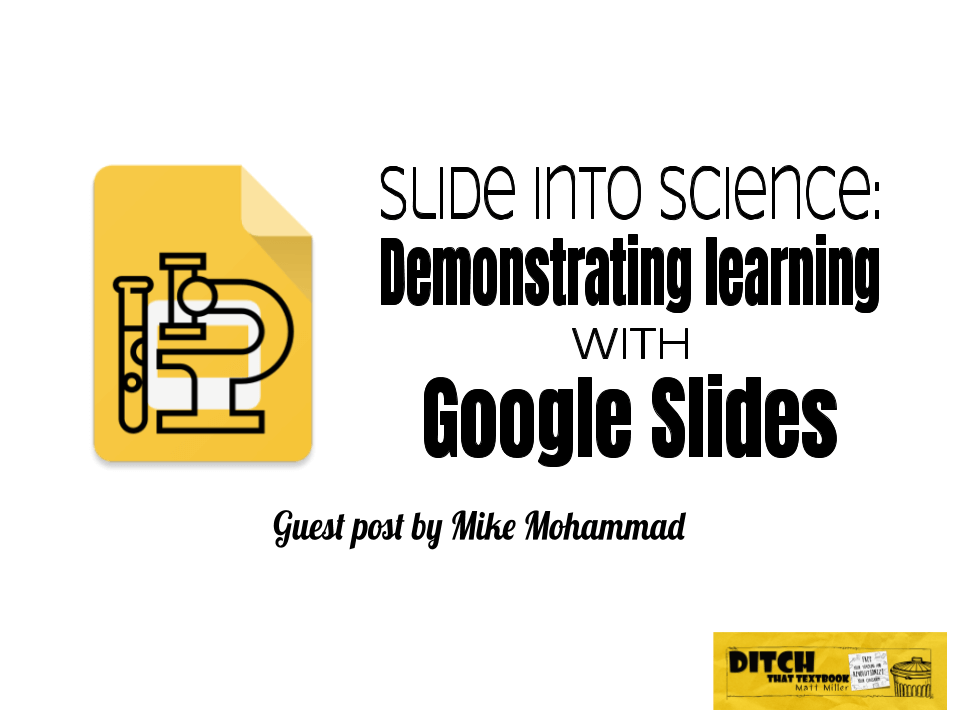

By rethinking how we use technology we can meet our science standards in new and engaging ways. Here are some ways you can use Google Slides in science class.
With the introduction of new standards across different content areas, the focus of learning has moved beyond simply mastering content knowledge to applying skills within disciplines. The Next Generation Science Standards is an example fo this. It contains 8 different science practices across all grade levels k-12.
They are:
Some schools will see this and think, “We don’t have enough science equipment for this!”
You may already have all you need with devices your students have access to. And this goes for any content area with evolving standards — English, math, social studies and beyond.
We have converted our lab reports from Google Docs into Google Slides. It has opened up new possibilities for learners to demonstrate many of the NGSS science practices.
Here are three examples you can start using in your classroom now:
When looking at models in the science classroom, we are looking at representations or a system or part of a system. Imagine students are being asked to create a model explaining how a Cartesian Diver, as seen below, works.

Original: On a traditional worksheet, a question like this would have space below for students to create a model using drawings and text.
Better: The same situation can be created within a Google Doc by inserting a Google Drawing.
Transformational: In Slides, we can allow learners to take this even further.
The point is that the ability for more avenues of expression allows learners to choose a path of communication with the least barriers.

Think of a traditional science procedure on a worksheet. I’ll bet you are thinking of a list numbered steps for students to follow.
With Google Slides, we have the ability to go way beyond this.
Instead, embed videos on a slide. Teachers can present procedures to students as short videos. You can record with your camera or use a tool like Flipgrid (flipgrid.com) or Screencastify (screencastify.com) or others.
These videos make directions crystal clear. Students can pause, rewind, and review. They don’t even have to raise their hand to ask for help.
In the example above, the teacher created instructional videos. Students can make these videos, too!
We can skip having students create a numbered written procedure. Try student-created video. This could be a full-blown live procedure walkthrough. It could something simpler: a direct video address to camera simply explaining the step-by-step procedure for the lab.
Ask students to analyze data. They determine the meaning of data. They look for patterns. Then, traditionally, they write about their findings.
Google Slides lets students go beyond just writing. They can show what they’ve learned by annotating their data presentations.
With text boxes, shapes, audio, video, images and more, there are limitless possibilities!
Imagine students took photos of a lab. They could easily insert that image into a slide. Draw on top of that image. Add text boxes or audio explanations.

This works great for graphs as well. Students can use the drawing tools to explain exactly what is happening in the graph.

Using Google Slides may not fundamentally change the science practices in an activity. But, Slides provides new ways to demonstrate mastery.
In addition to scaffolding for those who need it, its richer multimedia can provide greater student challenge.
More Google Slides resources:
For notifications of new Ditch That Textbook content and helpful links:
Interested in having Matt present at your event or school? Contact him by e-mail!
Matt is scheduled to present at the following upcoming events:
[getnoticed-event-table scope=”upcoming” max=”15″ expanding=”false”]

Session expired
Please log in again. The login page will open in a new tab. After logging in you can close it and return to this page.
I have not used Google Slide yet, thank you so much for the helpful post!
Very user friendly learning platform
With extensions needed in all modalities
[…] Measure temperature, rain, changes in foliage, sightings of animals or any other natural phenomena. Invite another class to do the same. Then get together in a video call to discuss your hypotheses and/or findings. You can use Google Slides to create a collaborative document that students can add to together. Lots of ideas in this post Slide into science: Demonstrating learning with Google Slides. […]